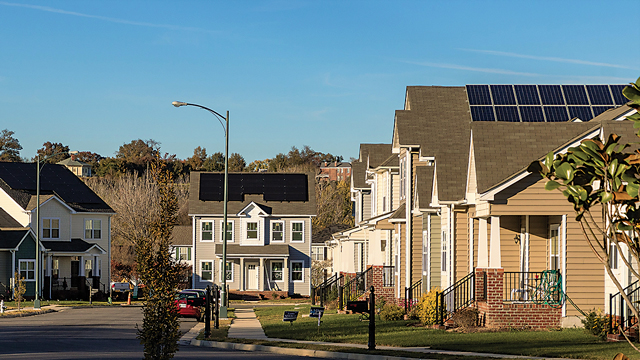(photo) Designed as a neighborhood for low-to-moderate income families, The Villas at Rockett’s Landing are priced from $200,000 to $300,000, with enough solar to virtually eliminate their electric bills.
Now is a great time to invest in residential solar in Richmond. Price, availability, tax credits, and power suppliers are all aligned to create a positive buying opportunity. However, changes on the horizon suggest that this alignment might not last for long.
According to Zak Dowell, co-owner of Richmond’s Sustainable Technology Institute, the market is in a sweet spot for residential solar because systems are priced at an all-time low, the 30 percent federal tax credit is scheduled to disappear in a few more years, and a 1 percent cap law could go into effect at any time. “The system efficiency and aesthetics have improved, so now with an all-black panel and racking system, the product looks nicer on the home and generates more energy per panel,” says Dowell.
This means whether you’re building a new home or looking to upgrade, solar power might be a smart option for your home. The cost makes this a practical reality for most homeowners. There are many financing options, and the long lifespan of the system allows them to offer years of service.
Over the past several years, solar component prices have been dropping significantly due to increased demand and availability. At the same time, efficiency and generating capabilities have been rising dramatically due to technological advances. In the six years I’ve been in the industry, prices for residential photovoltaic systems (PV) have dropped from $7.00/watt to $2.50/watt. The system that is installed today costs less and delivers more energy per panel versus twenty, ten, or even five years ago. To install a 5-kilowatt system on the average 2,000-square-foot home built in the last twenty years, it would cost about $13,500, less the 30 percent federal tax credit of $4,050 for a total investment of $9,450. This system should offset approximately $100 per month of the electric bill for a total savings of $1,200 per year. At this rate, the system will pay for itself in about 7.8 years.
What does a grid-connected residential solar photovoltaic (PV) system look like? The most visible portion of the system is the PV module (or panel) itself. This is where energy absorption and conversion takes place when the sunlight is strong enough to create the necessary reaction. Electrical wiring and conductors carry the newly created juice to the inverter. The electricity is created in direct current (DC) mode, so it must be converted to alternating current (AC) before it is used in the home or sent out to the grid. That’s the primary job of the inverter, but it can also give the system owners vital data about system output, efficiency, and working conditions.
Most often, these systems are designed to feed power to the grid in exchange for credit toward the owner’s electric bill. This is called net metering, and here’s how it works: the electric company agrees that the energy sent to the grid is worth a certain amount per kilowatt hour (kWh). Smart electric meters record accurately in either direction, so when the solar energy system is generating more power than the home
is consuming, the meter spins backward. The monthly bill is the net difference between the energy consumed and the energy generated.
Let’s look at the typical home and what happens during the day when the sun is at peak efficiency. There is a flurry of morning activity when bigger kids head off to school, and one or both parents are off to work. Because many homes have fewer people in them during the day, they are consuming very little power. That home’s solar power system could be sending a significant amount of energy to the grid during these hours. Once everyone comes home, the use swings the other way.
With the increase of solar co-op programs across the state, the cost and concerns of using solar energy are being addressed. These are short-term programs in a certain geographical area that allow homeowners to sign up if they are interested in going solar. Members of these programs receive education on the systems and a free home inspection to determine if solar is a viable option for their residence. Then they purchase an installed system with the pricing structure related to other members in the co-op.
There is currently a solar co-op forming in Richmond. For more info, visit vasun.org. Aaron Sutch with VA Sun moderates many of these programs and has seen hundreds of homes go solar in the last three years. “With recent cost declines, many Virginia families are finding it economical to produce clean, local energy with solar,” says Sutch. “Just like having a vegetable garden, solar on our homes teaches our children important lessons in self-sufficiency and environmental stewardship.”




